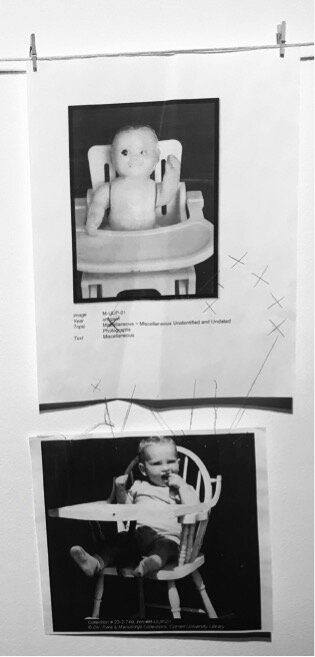Practice Babies
“What is that Leaping Inside Your Chest?” Collar Works Gallery, Troy, NY
curated by Alexandra Foradas, assistant curator, MassMoCA
Their names were Dick, Dicky, Dickey, Dickie, and Donny. There was Bobby, Bobbie II, Donny, Grace, Edna Mae, and Joan. They were also called “Apartment Babies,” or “Practice Babies.” The one thing they had in common was their last names–Domecon; short for Domestic Economy.
Taken from local orphanages, asylums, and almshouses, hundreds of babies were chosen to help young ladies enrolled in the first degree for women in the country, Home Economics at Cornell, apprentice for motherhood. Six different “Practice Mothers,” lived with, cooked, cleaned and raised the babies as their own in a “Practice Apartment.” Awakened, fed, diapered, and pottied on a strict scientific schedule over the course of ten months, these “superbabies” were fatted and then considered adoptable.
Their identities were erased as were all records of them being in the program. In some cases their birthmothers came looking for them, but were denied their babies. After 10 months to a year, the Apartment Babies were adopted into homes around New York State.
The remaining breadcrumbs of their existence are these few archival images. I restaged the photos in The Dollhouse as a way of making amends for the past, perhaps, and a way of claiming mine as an adopted child.
When I was a child, I wanted to control the world because as an adoptee, I felt like I had no control. Children play to control the world. Tiny themselves, they create even smaller worlds populated by all sorts of figures, friends to have tea with, monsters to defeat, new microcosms to explore what is inside them via the outside world.
As an adopted child, I often created dioramas, imagining myself into another life. It didn’t matter the tiny stage, these were worlds into which I disappeared for an afternoon.
At 29, I learned that my birthmother became pregnant with me and had been sent away to a home for unwed mothers—The Guild of the Infant Saviour, in Manhattan—I realized we had more in common than just the circumstance of my birth: we both had disappeared inside fantasy worlds. Mine was tiny, imaginary, and voluntary; hers was all too real.
I began The Dollhouse to explore my personal history as well as to interrogate the ideas of adoption, identity, feminism, and home. The Dollhouse allows me to create a world where women rule, at least on the 1:12-scale. But these small utopias are hyper-sexualized and constrain their female citizens to Madonnas or Whores. The Dollhouse, a 1960s-era Louis Marx “Marxie Mansion,” is thus peopled with images of women from the era of my mother’s confinement, and creates a two-way portal to imagine myself into her life, and imagine her into mine. By displaying the matriarchal fixtures of the time, I explore what has changed, and what remains.











